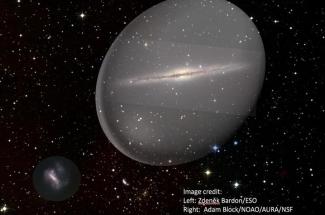UK Astronomy Student Leads Study on Shape, Structures of Milky Way Galaxy

Austin Hinkel, a doctoral student in the University of Kentucky Department of Physics and Astronomy, is the lead author of a new paper that published today in the Astrophysical Journal (ApJ).
The study, "Probing Axial Symmetry Breaking in the Galaxy with Gaia Data Release 2," was led by Hinkel along with co-authors Susan Gardner, professor of physics and astronomy in the UK College of Arts and Sciences, and Brian Yanny, a staff scientist and astrophysicist in the Fermilab Center for Particle Astrophysics in Batavia, Illinois.
"Using powerful ideas borrowed from nuclear and particle physics, we explore the axial symmetry, or axisymmetry, of the galaxy — that is, if one looks out from the center of our galaxy, toward the sun, does the disk of the Milky Way look the same left and right? We check this by counting up the stars near the sun and comparing their distributions left and right," Hinkel said.
Hinkel and team used star data from the Gaia database, which has collected more observations than any previous survey. Hinkel says even tiny breakings from axisymmetry can reveal dynamic (and previously unknown) effects in our galaxy.
"The Milky Way disk is thought to be surrounded by a dark matter halo, the shape of which we have had no way of observing directly," Hinkel said. "By examining the axial asymmetry of the visible portion of the galaxy, we are sensitive to the gravitational effects exerted by such unseen matter and thus are able to determine the shape of the dark matter halo surrounding our galaxy from the axisymmetry breaking pattern."
Hinkel and team's findings support the idea that the dark matter halo is shaped like a tilted football, and it warps the outer regions of the stellar disk of the Milky Way through its gravitational interactions.
The team also found another axisymmetry-breaking effect that is attributable to the Milky Way's central bar, a region that Hinkel says is notoriously hard to study.
"Here (a little closer to the center of the galaxy), we have found that the breaking of axisymmetry changes quite abruptly," he said. "We attribute this change to an orbital resonance, and its location is a hotly debated topic. Our inference of its location from the asymmetries in local stellar orbits is a novel approach that avoids the complications associated with other methods."
"It is exciting to see how methodologies developed in other subfields of physics can be used to remarkable effect in a completely different context," Gardner said. "As our next step, we plan to use our results to determine the rotational frequency of the Milky Way’s central bar, which has also been very poorly known."
Brian Yanny participated in the work and hosted Hinkel and Gardner at Fermilab for short periods of in-person collaboration (they now meet virtually online).
"An initial analysis told us that the Large Magellanic Cloud, our Milky Way's largest satellite companion galaxy, was distorting the shape of the matter and stars in the vicinity of the sun," Yanny said. "An exciting follow-up came with refined star count observations by Austin and suggestion by Dr. Gardner to search for a star density pileup pattern predicted more than 50 years ago based on work of the Swedish astronomer Bertil Lindblad."
The ApJ paper can be found at https://iopscience.iop.org/article/10.3847/1538-4357/ab8235.




